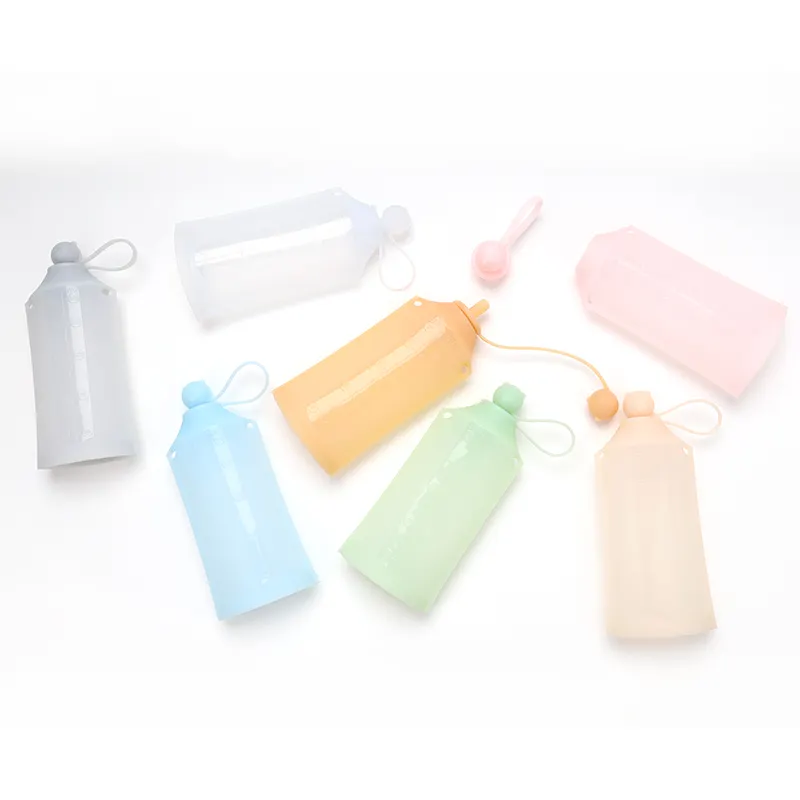Forståelse af sikkerhedsstandarder for brystmælkspose
Materialedele og FDA-overensstemmelse
At sikre sikkerheden for brystmælkstøjer starter med at forstå deres materialekomposition. Det er afgørende at vælge poser fremstillet af BPA-fri plastik eller andre materialer, der er sikre til brug for spædbørn. BPA, eller Bisphenol A, er en kemikal, der findes i plastik og har været forbundet med forskellige helbredsmæssige problemer, så udeladelsen af dette stof i produkter beregnet til spædbørnsbrug er afgørende. Ifølge FDA skal brystermælkeposer overholde specifikke standarder, som sikrer, at de ikke udleder skadelige stoffer i mælken. Disse standarder omfatter strenge tests for at certificere materialerne som fødevaresikre og ikke-toksiske. Udover BPA-fri plastik er medicinsk silikone et alternativ, som er voksende populært. Silikone opfylder hårde sikkerhedsregler og giver forældre ro i sindet med hensyn til forurening i plastik. Certificeringer såsom FDA-godkendelse spiller en væsentlig rolle for at skabe forældres tillid og sikrer, at produkterne er grundigt testet og sikre til brug for børn.
Almindelige sikkerhedscertificeringer man skal være opmærksom på
Ved udvælgelse brystmælkstøjer , kan efterspørgsel efter sikkerheds certificeringer markant styrke forbruger tillid og sikre produktets pålidelighed. Nogle vigtige certificeringer inkluderer ASTM (American Society for Testing and Materials) og ISO (International Organization for Standardization), som angiver, at produktet har gennemgået strenge kvalitets- og sikkerhedstests. Disse certificeringer forsikrer forældre om, at produkterne lever op til høje standarder og har bestået omfattende evalueringer af sikkerhed. Statistiske studier og citerede dokumenter fremhæver, hvordan certificeringer bidrager til produktets afhængighed – produkter med certificeringer rapporterer højere forbrugertilfredshed på grund af den opfattede pålidelighed og sikkerhed. Forældre kan verificere disse certificeringer ved at tjekke produktets emballage eller besøge producentens hjemmeside for bekræftigelse. Dette trin sikrer, at produkterne lever op til deres forventninger til sikkerhed og giver ekstra tryghed for deres babys velvære.
Opbevaring af morsmælk i fryser: Bedste praksisser for sikkerhed
Optimal Frysningstemperaturer og Varighed
At sikre kvaliteten af frossen mælk starter med at opretholde den korrekte frysetemperatur. Ekspert anbefaler at indstille din fryser på -18°C eller derunder for optimal bevaring. Denne temperatur hjælper med at bevare næringsindholdet i brystmælk i op til 6 måneder. Desuden kan anvendelse af en dybfryser, i modsætning til en almindelig køleskabsfryser, forlænge bevaringstiden til 12 måneder. Denne metode er meget fordelagtig for mødre, der ønsker at opbevare mælk i længere tid.
Anbefalet frysetemperatur: Hold fryserens temperatur på -18°C eller koldere for at opretholde brystmælkens kvalitet.
Fordele ved dybfryser: Brug en dybfryser for at forlænge mælkebevaringen op til 12 måneder.
Ekspertmeninger: Ifølge laktationsrådgivere beholder brystmælk de fleste essentielle næringsstoffer og antistoffer i 6 måneder under optimale fryseforhold.
Det er vigtigt at forstå betydningen af varigheden, så jeg har herunder angivet en retningslinje:
- Køleskab: Op til 6 måneder
- Fryser: Op til 12 måneder
Brystmælkens næringsprofil kan beskyttes ved at følge disse anbefalinger.
Undgå kontaminering under opbevaring
Korrekt opbevaring er afgørende for at forhindre kontaminering og sikre brystmælkens holdbarhed. Det er vigtigt at anvende sterile opbevarelsesposer, der er specielt designet til frysning. Disse poser spiller en væsentlig rolle i at undgå frostskader og forurening, som kan føre til næringsstofforbere og bakterievækst.
Anvendelse af sterile opbevarelsesposer: Vælg poser, der er beregnet til frysning, for at minimere risikoen for kontaminering og bevare mælkens kvalitet.
Almindelige fejl i opbevaring: Undgå at bruge uegnede beholdere og sørg for, at poserne er godt lukkede for at undgå frysebrænd.
Bedste praksis: Opbevar mælket med det samme efter det er pumet, og mærk poserne med dato for at følge friskheden nøjagtigt.
Studier har fremhævet de risici, der er forbundet med utilstrækkelige opbevaringspraksisser. For eksempel kan upålideligt lukkede beholdere eller anvendelse af ikke-sterile poser introducere bakterier, hvilket kan føre til potentielle helbredsrisici for spædbarnet.
For at understøttete sikkert opbevaring, skal poserne være BPA-fri, da forskning antyder, at eksponering for BPA kan føre til helbredsmæssige komplikationer. Ved at følge disse retningslinjer sikres det, at morsmælken forbliver sikker og næringsrig for dit barn.
Sikker optøning og opvarmning af morsmælk
Sikre optøningsmetoder (køleskab vs. varmt vand)
At tø af brystmælk sikkert er afgørende for at bevare dens ernæringsmæssige integritet og sikre, at den er sikker for babyen. Køleskabsmetoden anses bredt for at være den mest sikre løsning, da den muliggør langsom og jævn opfrysning og minimerer risikoen for bakterievækst. Ved at bruge varmt vand sikres hurtig opfrysning, hvilket kan være en fordel, når tiden er begrænset, men det er vigtigt at undgå direkte nedsænkning for at forhindre potentiel overophedning. Ekspert anbefaler at lade brystmælken tø i køleskabet om natten for optimal bevarelse af næringsstoffer og henviser til en tidsramme på op til 24 timer. Desuden er det vigtigt at følge sikkerhedsforholdsregler under opfrysningen, såsom at undgå længere tid ved stuetemperatur, for at fastholde mælkens kvalitet og forhindre forurening.
Hvorfor mikrobølger er en stor risiko
Opvarmning af brystmælk i mikrobølgeovn medfører betydelige risici på grund af den ujævne varmefordeling, hvilket skaber varmepunkter i mælken. Den intense varme kan ikke alene ødelægge essentielle næringsstoffer, men også udgøre en risiko for at barnets mund brænder sig på for varme sektioner. Videnskabelige studier dokumenterer tilfælde, hvor anvendelse af mikrobølgeovn har ført til næringsstofforbort og potentielle sikkerhedstrusler, hvilket understøtter børnelægernes advarsel mod brug af mikrobølger til opvarmning af mælk. Den intense varme kan nedbryde proteiner og antistoffer, som er afgørende for barnets sundhed, hvorfor alternative metoder såsom badning i varmt vand eller forsigtig opvarmning i rene beholdere anbefales af professionelle. Studier offentliggjort af sundhedsmyndigheder fremhæver vigtigheden af at undgå mikrobølgeovne for at sikre, at brystmælken forbliver sikker og sund for dit barn.

Opbevaringstips for at bevare næringsintegritet
Mærkning og organisering af din mælkeforråd
At korrekt mærkning og organisering af din mælkeforråd er afgørende for at sikre madhygiejne og kvalitet. Start med at mærke hver mælkesæk med dato og tidspunkt for hvornår den blev malket, hvilket hjælper med at forhindre fordærv og sikrer, at du bruger den ældste mælk først. Ved at implementere organisatoriske metoder såsom FIFO-systemet (First In, First Out) kan det yderligere understøtte en ordnet anvendelse. Denne teknik er især effektiv, fordi den prioriterer den ældre mælk og dermed reducerer risikoen for, at den ikke bliver brugt. For nem identifikation og effektiv opbevaring kan du overveje at bruge farvekodede etiketter, der angiver bestemte dage eller tidspunkter i løbet af ugen. Ekspertanbefalinger fremhæver, at omhyggelig mærkning ikke kun hjælper med at bevare mælkens kvalitet, men også bidrager til mælkens samlede sikkerhed. Ifølge Centers for Disease Control and Prevention kan korrekt mærkede og organiserede mælkeforråd markant reducere risikoen for at give spildt mælk til babyen og sikre, at dit barn modtager de mest friske næringsstoffer.
Undgå temperatursvingninger i køleskab/fryser
At opretholde konstante temperaturer i både din køleskab og fryser er afgørende for at bevare ernæringsmæssig kvalitet i morsmælk. Temperatursvingninger udgør en risiko, da de kan få mælken til at blive ødelagt og dermed uspiselig. Derfor anbefales det at indstille dit køleskab til 39°F (4°C) og din fryser til -0,4°F (-18°C) for at forhindre fordærv. Ved regelmæssigt at overvåge disse temperaturer sikres et optimalt lagringsmiljø for mælken. Studier har vist, at selv mindre temperaturændringer negativt kan påvirke morsmælkens ernæringsmæssige kvalitet, herunder nedbrydning af vigtige næringsstoffer som vitamin C. For bedste praksis bør mælk altid opbevares bagerst i køleskabet eller fryseren, hvor temperaturen er mest stabil. For at beskytte mod temperatursvingninger kan du overveje at investere i et pålideligt termometer til dine opbevaringsområder. Ved at fastholde strenge temperaturkontroller og undgå hyppige svingninger kan du sikre, at den opbevarede morsmælk beholder sin ernæringsmæssige profil.
Almindelige fejl ved brug af brystermælkesække
Når det gælder brugen af brystermælkesække, er overfyldning en almindelig fejl, som forældre ofte begår, hvilket fører til utætheder og udspild. Overfyldning sker, når sækene fyldes over deres kapacitet, hvilket kompromitterer seglens tæthed og øger risikoen for lækage. For at forhindre dette anbefales det, at forældre følger de fyldningsniveauer, der er angivet af laktationskonsulenter, og som regel efterlader lidt plads i toppen til mælken kan udvide sig, når den fryses. Statistikker viser, at forekomsten af utætheder stiger markant, hvis sækene overfyldes, hvilket kan føre til spildt mælk og tab af næringsstoffer.
Genbrug af brystmælksposer er en anden usikker praksis, som kan kompromittere spædbarns sundhed på grund af risikoen for forurening. Ved første anvendelse sikrer posernes materiale et sterilet miljø, hvilket er afgørende for sikkert opbevaring af mælk. Ved genbrug kan disse poser dog nedbrydes, hvilket kan føre til potentiel eksponering for skadelige bakterier. Sundhedsmyndigheder, herunder Centers for Disease Control and Prevention, advarer kraftigt imod at genbruge engangsartikler som brystmælksposer. Der har været tilfælde, hvor spædbørn har udviklet helbredsmæssige problemer ved indtag af mælk opbevaret i genbrugte poser, hvilket understreger vigtigheden af korrekt hygiejnepraksis i forbindelse med opbevaring af mælk.
Ofte stillede spørgsmål
Hvorfor er BPA skadelig i brystmælksposer?
BPA eller Bisphenol A er skadeligt, fordi det kan frigive sig til brystmælken og er forbundet med forskellige helbredsmæssige problemer, herunder hormonforstyrrelser hos spædbørn.
Hvordan kan jeg verificere certifikaterne for brystmælksposer?
Du kan verificere certificeringer ved at tjekke produktets emballage efter mærkninger som ASTM eller ISO eller besøge producentens hjemmeside for mere information.
Hvad er risikoen ved opthawing i mikrobølgeovn for modermælk?
Opthawing i mikrobølgeovn medfører risiko for ujævn varmefordeling, der skaber varmepunkter, hvilket fører til næringsstofforbæring og mulige brandskader i de stærkt opvarmede områder.
Hvordan undgår jeg almindelige opbevaringsfejl med modermælk?
Undgå opbevaringsfejl ved at bruge sterile poser, der er beregnet til frysning, lukke poserne godt og mærke hver pose med dato for at følge friskhed.

